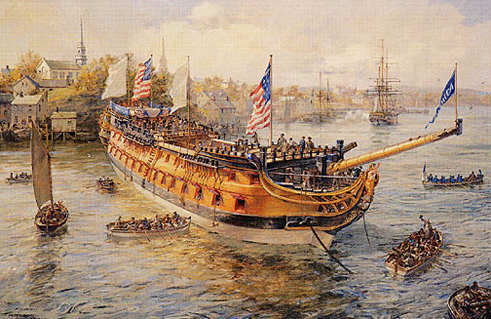17. Portsmouth Naval Shipyard
Located: 1st floor alcove outside Courtroom B
Print in courthouse exhibit: Geoff Hunt, Launching Day, USS America
The text tells the story of the Revolutionary War ship-of-the-line that was given to France before it ever set sail on behalf of its namesake country.

USS America
November 5, 1782
The launching of the largest American-built warship of the Revolutionary era, a 182-foot, 74-gun ship-of-the-line, was a pre-eminent but bittersweet occasion for the patriots who had overseen her construction near Portsmouth, New Hampshire. Stymied by a lack of funds, skilled craftsmen, and well-seasoned timber since Congress' authorization of the project in the fall of 1776, the building process had dragged on for five war-torn years before John Paul Jones was chosen to command the aptly-named USS America. Arriving in Portsmouth to assume his new post at the helm of the mighty ship, the renowned navy captain immersed himself into the remaining construction work.
One year later, the ship was nearly ready for sea just as France’s ship-of-the-line, Magnifique, ran aground and was wrecked in Boston Harbor. With the War of Independence winding down, the Congress of the Confederation opted to present America as a gift to its revolutionary ally. This painting captures the 182-foot vessel’s delicate launch into the swift current of the Piscataqua River, facilitated by a carefully timed release of a series of ropes to control her acceleration.
Just three years later, the vessel that John Paul Jones had hoped would be his fifth American naval command was deemed unfit for service when French surveyors discovered extensive and irreparable dry rot, most likely due to the use of green timber in her war-time construction. By 1787, France had built and launched a new 74-gun ship, also named America.

Launching Day, USS America - (Geoff Hunt)



